AMD Financial Analyst Day 2020 Round-Up: Laying A Path For Bigger & Better Things
by Ryan Smith on March 5, 2020 8:15 PM EST- Posted in
- CPUs
- AMD
- Radeon
- GPUs
- Infinity Fabric
- Zen 3
- RDNA2
- AMD FAD 2020
- CDNA
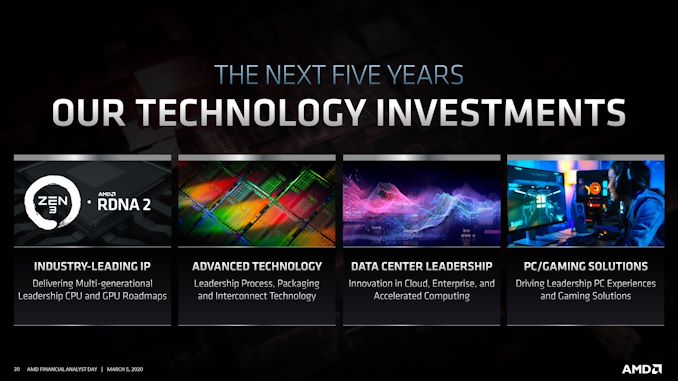
AMD’s first Financial Analyst Day since 2017 has just wrapped up. In the last three years AMD has undergone a dramatic change, launching its Zen CPU architecture, and greatly improving the trajectory of a company that was flirting with bankruptcy a few years ago. And now that AMD’s foundation is once again secure, the company has gathered to once again talk to its loyal (and looking at stock prices, now much richer) investors and how it’s planning to use this success to push into bigger and better things.
We’ve been covering FAD 2020 throughout the afternoon, and we have seen AMD make a number of announcements and roadmap reveals throughout the event. The individual announcements are below, and meanwhile now that the event has wrapped up we want to provide a quick summary of what AMD is going to be up to over the next five years.
AMD Shipped 260 Million Zen Cores by 2020
AMD Discusses ‘X3D’ Die Stacking and Packaging for Future Products: Hybrid 2.5D and 3D
AMD Moves From Infinity Fabric to Infinity Architecture: Connecting Everything to Everything
AMD Unveils CDNA GPU Architecture: A Dedicated GPU Architecture for Data Centers
AMD's 2020-2022 Client GPU Roadmap: RDNA 3 & Navi 3X On the Horizon With More Perf & Efficiency
AMD's RDNA 2 Gets A Codename: “Navi 2X” Comes This Year With 50% Improved Perf-Per-Watt
Updated AMD Ryzen and EPYC CPU Roadmaps March 2020: Milan, Genoa, and Vermeer
AMD Clarifies Comments on 7nm / 7nm+ for Future Products: EUV Not Specified
The big takeaway from the financial side of AMD is of course that the company is profitable. After at one point having more debts than cash, careful spending on AMD’s part along with the success of their Zen CPUs and recent GPUs has lifted AMD’s fortunes greatly. The company is now consistently profitable, revenues are growing, and at the same time it’s able to deliver results to shareholders while still using their new success to increase investments in critical R&D.
As a result, the AMD of 2020 is a much different company than the AMD of 2017. Instead of needing to survive, as was the case in 2017, AMD in 2020 gets to thrive. And as a result CEO Dr. Lisa Su is looking to taking AMD on to bigger and better things; to leverage AMD’s strengths to grow the company’s market share and take advantage of new opportunities, all while continuing her successful strategy of focused execution.
The big focus here (though far from sole) is on the data center market. Long the breadbasket of Intel and increasingly NVIDIA as well, it’s a highly profitable market that continues to grow. And it’s a market that slipped away from AMD, and which they’re now clawing back on the strength of their EPYC processors. Over the next 5 years AMD wants to take a much bigger piece of the total data center pie, and in fact the company expects to cross 10% market share of data center CPUs this next quarter. Which, by our reckoning, would be the first time they've hit that kind of market share in a decade (if not more), showing just how much things have changed for AMD.
The biggest tool here of course will be pushing the envelope with future EPYC processors. Showing off an extended roadmap for EPYC processors that goes out to AMD’s Zen 4 CPU architecture, the company is hard at work on its Milan and Genoa. Genoa in particular is a hot topic, as the United States Dept. of Energy just selected it to be used as the CPU in the forthcoming, 2 exaflop El Capitan supercomputer.
And the GPU? A part based on AMD’s forthcoming CDNA 2 compute GPU architecture.
Revealed today as part of AMD’s roadmaps, CDNA is AMD’s new designation for their compute-focused GPU architecture. A successor of sorts of the GCN architecture used in previous server GPUs like Vega 20, AMD’s server GPUs are now a distinct family separate from AMD’s RDNA architecture and the consumer GPUs that come from that branch of the family. By focusing on compute features, machine learning performance, and multi-GPU scalability, AMD has ambitious plans for their server GPU architecture. The CDNA family will see its first dedicated GPU released later this year, while GPUs based on the CDNA 2 architecture are due by the end of 2022.
Along with great GPU performance, the other big upgrade for the CDNA family is incorporating AMD’s Infinity Architecture (née Infinity Fabric). Already extensively used in AMD’s EYPC CPUs, the interconnect technology is coming to AMD’s GPUs, where it will play a part both in AMD’s multi-GPU efforts, as well as AMD’s grander plans for heterogeneous computing. With the third generation of the technology scheduled to offer full CPU/GPU coherency, allowing for a single unified memory space, the Infinity Architecture will be how AMD leverages both their CPU and GPU architectures to secure even bigger wins by using them together.
And not to be left out of all of this are AMD’s consumer products. While admittedly not receiving quite the same focus today as their server products – there isn’t quite the same opportunity for profit growth – AMD is hard at work for new consumer CPUs and GPUs.
On the GPU side of matters, AMD dropped a few more details on their previously revealed RDNA 2 architecture. With GPUs (and game consoles) using the architecture due to arrive later this year, RDNA 2 and the Navi 2X GPUs based on it will offer a mix of new features and efficiency improvements. With regards to features, the updated architecture will add hardware ray tracing as well as variable rate shading, closing the feature gap with rival NVIDIA. Meanwhile AMD is touting a 50% improvement in performance-per-watt, a sizable jump in efficiency that would be on par with the original RDNA architecture.
And AMD is aiming high, as well. After playing second-fiddle to NVIDIA for the past few years in terms of the performance of their top GPUs, AMD is planning to offer video cards with top-tier performance, capable of delivering “uncompromising” 4K gaming. AMD’s rivals won’t be standing still, of course, but AMD believes they have the technology and the energy efficiency needed to deliver the extreme performance that enthusiasts are looking for.
Following RDNA 2 will be RDNA 3. AMD isn’t saying much about the architecture other than that the chips for it will be the Navi 3X family, but it will iterate on RDNA2 by delivering even greater improvements in performance and efficiency. The architecture is slated to use a new process node – so not the 7nm variant used in RDNA 2 – but AMD is not disclosing that node at this time, opting to simply label it as “advanced node.” RDNA 3 GPUs will show up by the end of 2022.
As for AMD’s consumer CPUs, as mentioned previously, the development of their Zen 3 CPU architecture remains on track. So fourth generation Ryzen processors based on the updated CPU architecture are expected by the end of this year (though, we suspect, after Zen 3 ships for EPYC).
Finally, along with specific product updates, AMD also talked briefly about some of their general technology focuses over the next 5 years. As Moore’s Law is continuing to slow down, newer and more exotic chip packaging methods are required to keep chip performance improvements going. And AMD, who is already well-versed in 2.5D technologies thanks to its use of chipsets on Zen 2 processors, is also looking at 3D stacking.
Dubbed “X3D”, the company wants to use a hybrid of 2.5D and 3D stacking to achieve a significant increase in bandwidth density. All told, AMD is touting a potentially better than 10x improvement in bandwidth density over today’s chiplets if their plans come to fruition.
Finally, the focus on future technologies has also required that AMD take a bit more care in what they say regarding future manufacturing nodes. AMD’s 2020 roadmaps have scrubbed any mention of “7nm+”, which was on their future roadmaps, in order to avoid any confusion with TSMC’s EUV-based “N7+” node. To be sure, AMD’s so-called second generation of 7nm parts will still be using an enhanced version of 7nm versus the variant used on current Zen 2 and Navi chips, but AMD is being a little more careful as to not imply that it’s going to be EUV-based.
And with that, that’s a wrap on AMD’s 2020 Financial Analyst Day. The company has laid out an aggressive roadmap with regards to both technology and what it means for their financial performance, so now it will be up to Dr. Lisa Su and the rest of AMD to deliver on those lofty goals. Coming off of a remarkable turnaround over the last few years, AMD is in perhaps the best position it’s seen in almost a decade, and if AMD’s efforts can match their aspirations, then the next five years will undoubtedly launch them into a bigger and better place.


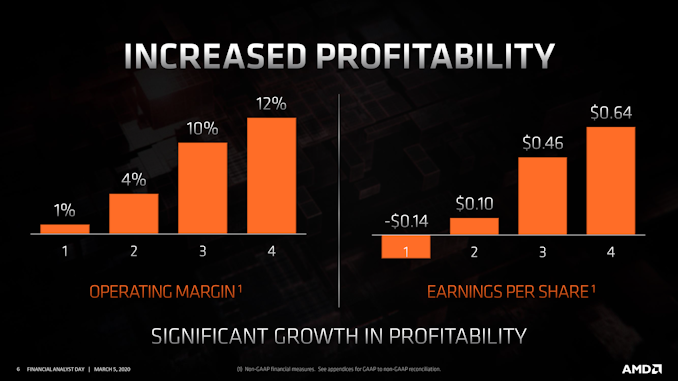
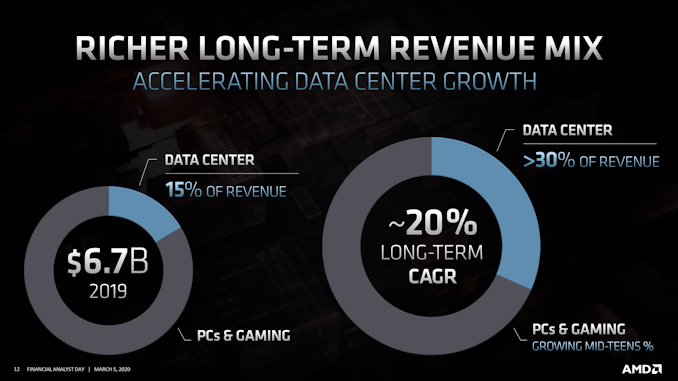
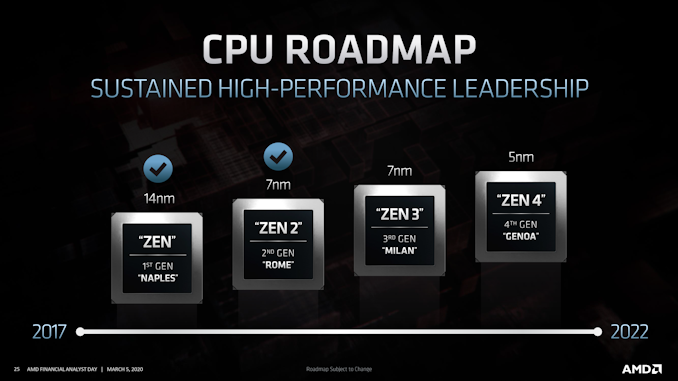
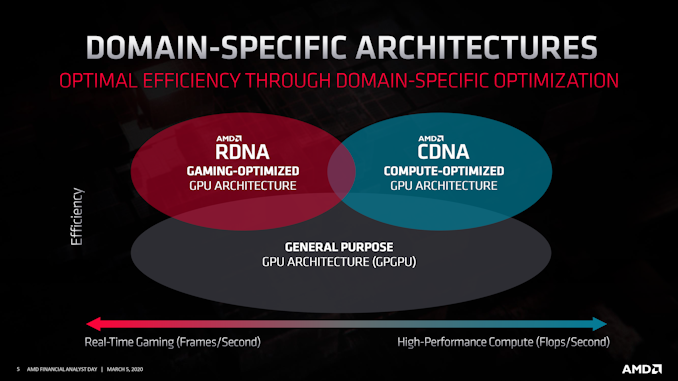
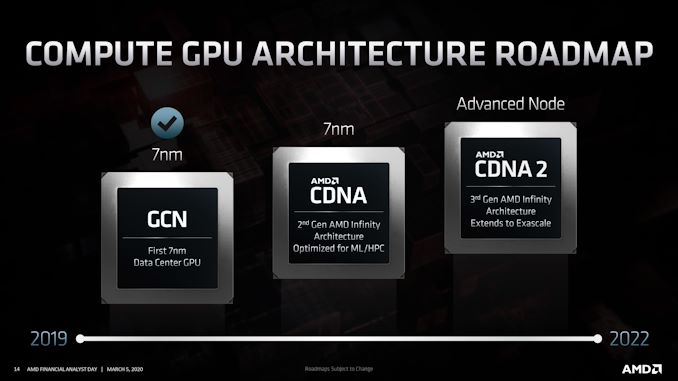
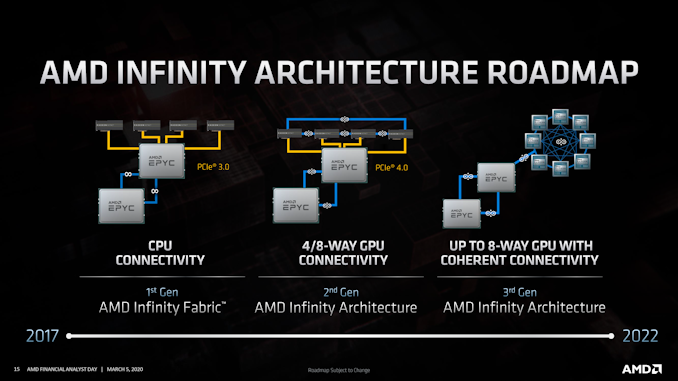

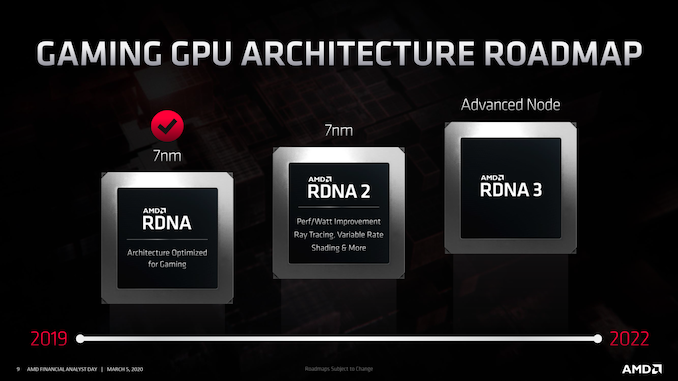
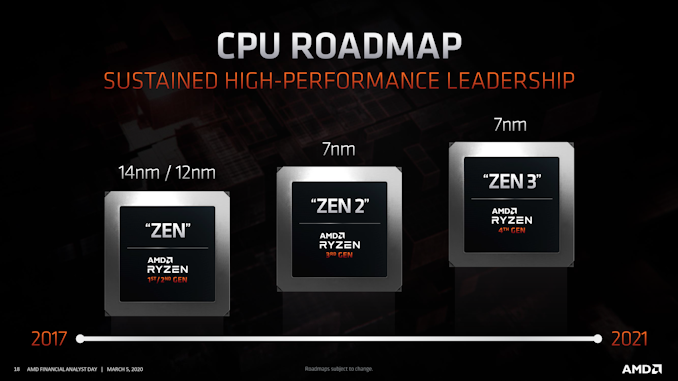
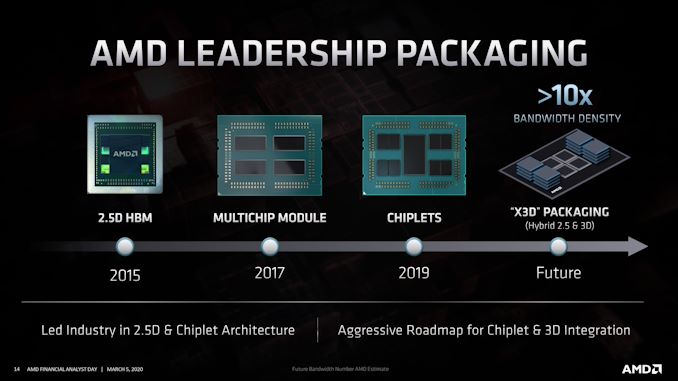
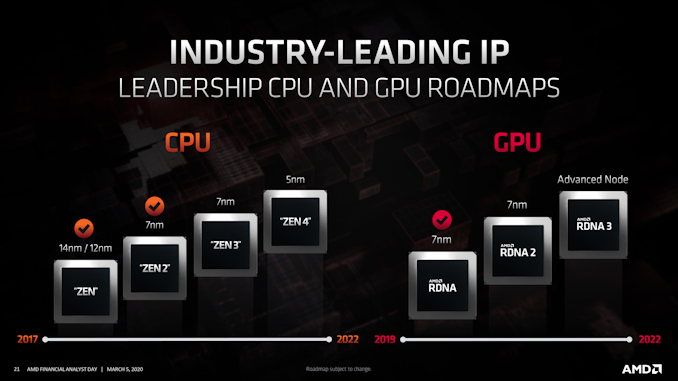








51 Comments
View All Comments
FreckledTrout - Friday, March 6, 2020 - link
+1ThelVadum - Friday, March 6, 2020 - link
You should check out the lastest videos on the subject from Digital Foundry and Hardware Unboxed. DLSS 2.0 as first implemented in Wolfenstein Young Blood is described as being virtually indistinguishable from native resolution, essentially giving a free performance boost (about 30 percent at 4k with the quality setting if I'm remembering correctly).TheinsanegamerN - Monday, March 9, 2020 - link
That matters about as much as the performance boost AMD recieved with mantle in battlefield. One games a card selling feature does not make.TheinsanegamerN - Monday, March 9, 2020 - link
Incredible promise? It's making your games blurrier and claiming its a feature. Just lower your resolution and installa shader mod. Boom, you have DLSS for free.DLSS may be the worst gimmick since Nvidia exclusive physx or AMD exclusive mantle.
Raptord - Friday, March 6, 2020 - link
"well-versed in 2.5D technologies thanks to its use of chipsets on Zen 2 processors"I believe this meant to say "chiplets" rather than "chipsets", no?
WaltC - Friday, March 6, 2020 - link
Just to clarify a point--AMD did not say they weren't using 7nm+; what they said was that most if not all of the + features--including EUV, I presume--had been rolled into the standard "7nm" TSMC process they'll be using. That's the way it appeared to me, anyway. I recall Papermaster talking about that. Looks like just a simple nomenclature change.WaltC - Friday, March 6, 2020 - link
It also occurs to me that possibly they only spoke of 7nm+ EUV from Samsung for mobile--not yesterday--but some months ago--interesting though.Yojimbo - Friday, March 6, 2020 - link
AMD's on a roll, but there's an elephant in the room when they tout their rosy plans. AMD spent $1.5 billion in R&D in the year just ended. NVIDIA spent $2.8 billion. Intel spent $13.4 billion. Of course Intel has many more pots on the fire than AMD, with Mobileye, their IoT stuff, and most notably their fabs, but you can bet that Intel is spending much more than $1.5 billion on stuff that competes directly with AMD's products, even if you exclude GPUs. So AMD is being outspent in R&D by their competitors by 3 to 1 or more. It would take a combination of genius on the part of AMD and stupidity by their competitors for that to play out in AMD's favor in anything but the short term.AMD can develop the best GPGPU hardware in the world, but without the software ecosystem they won't make a scratch in the market outside supercomputers. They can't develop that ecosystem with their current R&D spend. Zen is a good and successful product, but it came right at a time when Intel faltered with their 10 nm process. Not only has Intel been hurt in terms of process, but their troubles caused their new core architectures to hardly see the light of day as well. That situation is not going to last more than a year or two from now.
Shlong - Friday, March 6, 2020 - link
Well AMD had low R&D in 2016/2017 in comparison and came out with Zen. It's not how much you spend, it's about spending it efficiently which AMD excels at under Lisa Su.Yojimbo - Saturday, March 7, 2020 - link
Because AMD could get from 1 to 10 out of 100 by just making a piece of hardware, and because AMD came out with their chip right when Intel rain into some extremely fortuitous (for AMD) difficulties. But getting from 10 to 20 or to 30 or to wherever they hope to get is a different matter. There'll be less and less low-hanging fruit.Of course it's not about how much you spend, it's how you spend it. And, I repeat, if AMD can compete by spending less than 1/3rd the amount then they are geniuses and their competitors are morons.